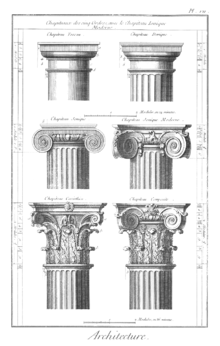
Back Klassieke orde AF نظام كلاسيكي Arabic Orderlərin növləri və strukturu AZ Архитектура ордеры BA Архітэктурны ордар BE Архітэктурны ордэр BE-X-OLD Ordres clàssics Catalan Ordine architetturale CO Klasická řádová architektura Czech Архитектура ордерĕ CV


An order in architecture is a certain assemblage of parts subject to uniform established proportions, regulated by the office that each part has to perform.[1] Coming down to the present from Ancient Greek and Ancient Roman civilization, the architectural orders are the styles of classical architecture, each distinguished by its proportions and characteristic profiles and details, and most readily recognizable by the type of column employed. The three orders of architecture—the Doric, Ionic, and Corinthian—originated in Greece. To these the Romans added, in practice if not in name, the Tuscan, which they made simpler than Doric, and the Composite, which was more ornamental than the Corinthian. The architectural order of a classical building is akin to the mode or key of classical music; the grammar or rhetoric of a written composition. It is established by certain modules like the intervals of music, and it raises certain expectations in an audience attuned to its language.[2]
Whereas the orders were essentially structural in Ancient Greek architecture, which made little use of the arch until its late period, in Roman architecture where the arch was often dominant, the orders became increasingly decorative elements except in porticos and similar uses. Columns shrank into half-columns emerging from walls or turned into pilasters. This treatment continued after the conscious and "correct" use of the orders, initially following exclusively Roman models, returned in the Italian Renaissance.[3] Greek Revival architecture, inspired by increasing knowledge of Greek originals, returned to more authentic models, including ones from relatively early periods.

- ^ Gwilt, Joseph (1842). An Encyclopædia of Architecture: Historical, Theoretical, and Practical. London: Longman, Brown, Green, and Longmans. pp. 680.
An order in architecture is a certain assemblage of parts subject to uniform established proportions, regulated by the office that each part has to perform.
- ^ Summerson, pp. 7–15
- ^ Summerson, pp. 19–21